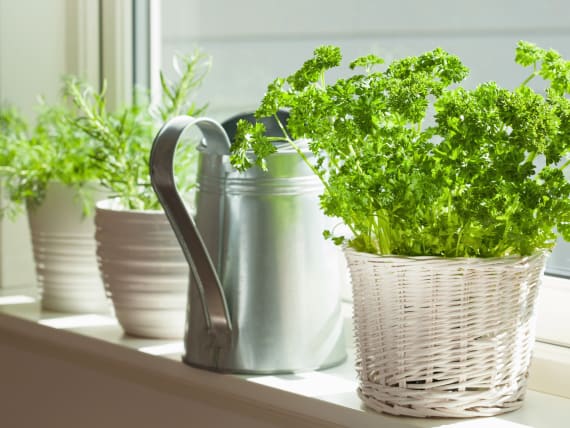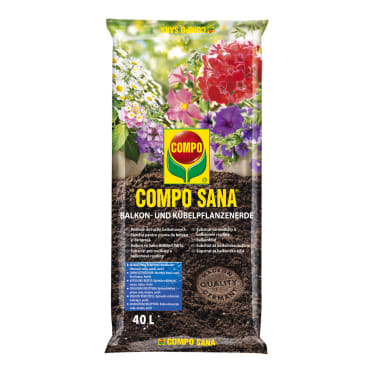Frequent search terms

- COMPO
- Guide
- Plant Care
- Basics
- Watering
- How to water your plants properly
Basics
The A-Z of watering.
Your plants get thirsty just like you! But how intensively and often they should be watered depends on many factors and is often a source of uncertainty. Whether houseplants, balcony and tub plants or turf, every plant has different needs. We reveal the most important basic rules to help you with watering.

Watering houseplants properly
Prevent waterlogging
The following generally applies: It is better to water once too little than once too much! Dried out plants can often be rescued, but it's too late for plants with rotten roots.
Be aware of the origin and location
The origin and location of a plant should be taken into account during watering: Your green roommate can cope with different amounts of water depending on the climate zone it comes from. It is best to ask the retailer directly when you make the purchase. When it comes to the location in your home, you should bear in mind that plants in warm spots with lots of direct sunlight will need a lot more water.
Pay attention to the leaf type
Plants with large leaves generally require more water than plants with a smaller leaf surface. The same goes for grooved or otherwise uneven leaf surfaces. But thick, fleshy leaves can store water well and should therefore be watered less.
Consider the vegetation cycle
When a plant grows (usually in summer), it needs a lot of nutrients and enough moisture to form new leaves and flowers. When the temperatures drop, many plants enter a resting period, during which they need less water and nutrients.
Select the appropriate pot size and material
Small plants in large pots can store water over an extended period and thus need to be watered less often. But larger plants with little space in their pots need to be watered more intensively and ideally planted in a pot that is 2-4 cm bigger as soon as possible. Plants in clay or terracotta pots need far more moisture than plants in plastic pots, as clay also stores water and releases it into the soil. Plastic pots cannot store water, so they need to be watered less.
Trust technical aids
It is usually hard to tell from the soil whether your houseplants need to be watered or not. The surface often dries faster, but it is still moist underneath. So, if the surface appears lighter shortly after watering, it doesn't necessarily mean that it needs to be watered again. Use the tried and tested thumb trick: Stick your thumb deep enough into the soil to test whether it is still moist enough. Although this is practical, it is also inaccurate as only the soil surface can be tested with this method. A hygrometer can help to determine the water requirement directly at the root balls.

Watering balcony and tub plants properly
Water with caution
Too much moisture makes the roots rot, with the result that the plant doesn't absorb any more nutrients and cannot develop properly. But too little water hinders its growth and ability to form flowers, leaving your plant with brown leaves and wilting. Generally speaking, it is better to water generously than in small amounts on a regular basis.
When to water
The best time to water is in the morning or in the evening. If it is too hot at noon, leaves that have accidentally been left wet can burn. What's more, an unnecessary amount of irrigation water evaporates before it can be absorbed by the plants. Incidentally, plants on the north side of the building need much less water than plants facing south.
Watering properly is key
Remember that your plants are sensitive souls! Tap water should not be too cold or limey. In areas with hard water, it is advisable to water terrace and balcony plants with rain water – this is good for both the plants and the environment!

Watering lawns properly
Watering the lawn is easier said than done. Many hobby gardeners have a hard time finding a suitable time and the right amount of water for their lawns. Some even abandon watering their lawns completely. But regular moistening is part of caring for lawns – especially in hot temperatures.
The best time to water
The best time of the day to water your lawn is in the morning or in the evening. The blazing midday sun would interact with the water and burn the lawn, leaving you with unsightly brown patches. A lot of water would also evaporate.
The factors influencing the water quantity
Depending on the soil conditions, temperature and humidity in the air, a square metre of lawn loses an average of four litres of water per day due to evaporation in the summer. If there are trees, shrubs or large bushes growing nearby that draw the water out of the soil, the moisture requirement will be higher than in open spaces. As the roots of the grass are only 15 cm deep in the soil, it quickly lacks the water needed for adequate growth. It is important that the area around the roots is completely soaked. Different water quantities are needed for this depending on the condition of the soil.
How much water your lawn needs
While lighter sandy soils need about 10 to 15 litres per square metre every three to four days in dry periods, loamy to clayey soils should be watered about once a week with 15 to 20 litres per square metre. If you water a small amount every day, the roots will pull back from the deeper layers of the soil. If it is not watered for an extended period, the lawn surface will dry out very quickly. For that reason, it is better that the roots stay deep so that they can also absorb water there.
Tip
The lawn should not be watered after weeding because weeds could grow back again. But after seeding it needs to be watered several times a day with a gentle water jet for two to three weeks.

How to tell if your lawn needs water
It is better to start watering the lawn too early than too late: If you wait until drought damage is visible, it will be difficult to turn the parched surface back into a green carpet. So, water your lawn regularly – even if it is still green. It is time to water when the first blades become limp and the grass doesn't stand up on its own after it has been walked on.
Soils with additional water storage capacities





